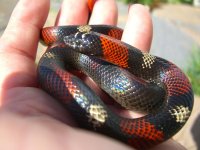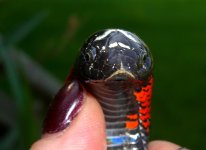Scarlet Kings are absolutely beautiful, and I would love to have one someday but they can sometimes be a nightmare to care for and feed (as was stated above). I've only known of one person that was able to successfully (and easily) rear, breed, and reproduce multiple Scarlets, and he happens to live in Fl where walking on your front porch is like walking into a lizard haven. Of course, it poses a challenge which can either be rewarding or disastrous depending on how you look at it.
If you want to stick with colubrids, there are some smaller Lampropeltis species that are similar to Scarlet Kings, but are easier to care for. New Mexican Milks, Ruthven's Kings, Pale Milks, Central Plains Milks, and Louisiana Milks. All of these are have the typical banded tricolor patterns, and most rarely exceed 30 inches. Most readily accept rodents for food, are also fairly hardy, and can be a joy to own. Some may be hard to find, but usually a devout Lampropeltis fan will have some uncommon subspecies stashed away

I was also going to suggest Rubber boas or Rosy boas. They are both very hardy, relatively easy to care for, and have very good temperaments. There are many locales to choose from that offer a variety of colors and patterns.
Another smaller species that is very common and can be easily cared for is just a plain Garter. Sure they have a bad reputation for being nasty, but they can be tamed down just the same. They eat a variety of things from fish to regular meat to rodents and are also very hardy. Like the Rubber and Rosy Boas, there are many different subspecies and locales that have beautiful colors and patterns. They are found
everywhere and I'm sure you might even be able to acquire one locally on a herping trip once the weather starts to warm up a bit.
A few of my personal favorite uncommon small snakes are Red Belly Snakes, Ringneck Snakes, Smooth Green Snakes, Dekays Brown Snakes, Ribbon Snakes, Scarlet Snakes (sometimes confused with Scarlet Kings), Queen Snakes, Longnose Snakes (though they can be difficult to feed as well), and Trinket Snakes.
Hope this helps!





